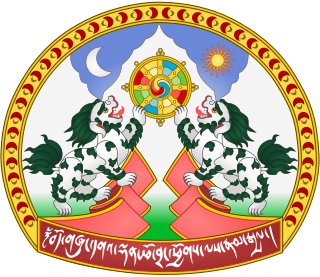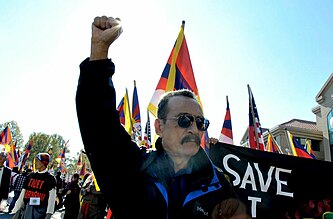
The Tibetan independence movement is the political movement advocating for the reversal of the 1950 annexation of Tibet by the People's Republic of China, and the separation and independence of Greater Tibet from China.

The national flag of Tibet (བོད་ཀྱི་རྒྱལ་དར།), also unofficially known as the Snow Lion Flag, depicts a white snow-covered mountain, a yellow sun with red and blue rays emanating from it, two Tibetan snow lions, a multi-coloured jewel representing Buddhist values, a taijitu and a yellow border around three of its four sides. The flag was used as the national flag of the independent country of Tibet from 1916 until 1951, when Tibet was annexed by the People's Republic of China. It was adopted by the 13th Dalai Lama in 1916 and used in Tibet until the Tibetan uprising of 1959, after which the flag was outlawed in the People's Republic of China. While the Tibetan flag is illegal in Tibet today as it is governed by the PRC as the Tibet Autonomous Region, it continues to be used by the Central Tibetan Administration, the Tibetan government-in-exile based in Dharamshala in India, and by pro-Tibet groups all over the world to show support for human rights in Tibet and Tibetan independence.
This is a list of topics related to Tibet.

The history of Tibet from 1950 to the present includes the Chinese annexation of Tibet, during which Tibetan representatives signed the controversial Seventeen Point Agreement following the Battle of Chamdo and establishing an autonomous administration led by the 14th Dalai Lama under Chinese sovereignty. Subsequent socialist reforms and other unpopular policies of the Chinese Communist Party led to armed uprisings, eventually assisted by the CIA, and their violent suppression. During the 1959 Tibetan uprising, the 14th Dalai Lama escaped to northern India for fear of being captured by Chinese forces. He formed the Central Tibetan Administration and rescinded the Seventeen Point Agreement. In 1965, the majority of Tibet's land mass, including all of U-Tsang and parts of Kham and Amdo, was established as the Tibet Autonomous Region. Tibetans suffered along with the rest of China during the Great Chinese Famine and the Cultural Revolution under episodes of starvation, religious repression, destruction of cultural sites, forced labour, and political persecution. US-China rapprochement in the 1970s saw an end to Washington's support for Tibetan guerillas. Amid broader reforms across the country, China adopted policies to improve conditions in Tibet. Since the 2000s, it has invested heavily in the region but generated controversies due to the sinicization of Tibet. Human rights abuses remain a concern especially where it comes to freedom of religion and political prisoners.

Thubten Jigme Norbu, recognised as the Taktser Rinpoche, was a Tibetan lama, writer, civil rights activist and professor of Tibetan studies and was the eldest brother of the 14th Dalai Lama, Tenzin Gyatso. He was one of the first high-profile Tibetans to go into exile and was the first to settle in the United States.

Kumbum Monastery, also called Ta'er Temple, is a Tibetan gompa in Lusar, Huangzhong County, Xining, Qinghai, China. It was founded in 1583 in a narrow valley close to the village of Lusar in the historical Tibetan region of Amdo. Its superior monastery is Drepung Monastery, immediately to the west of Lhasa. It is ranked in importance as second only to Lhasa.

Ngapoi Ngawang Jigme was a Tibetan senior official who assumed various military and political responsibilities both before and after 1951 in Tibet. He is often known simply as Ngapo in English sources.

The national anthem of Tibet, commonly referred to as "Gyallu", is a Tibetan patriotic song which serves as the de facto anthem of the Central Tibetan Administration.

The Tibetan Institute of Performing Arts (TIPA) was founded by Tenzin Gyatso, the 14th Dalai Lama on reaching McLeod Ganj, Himachal Pradesh, India in exile from Tibet in August 1959. It was then called Tibetan Music, Dance and Drama Society, which was one of the first institutes set up by the Dalai Lama, and was established to preserve Tibetan artistic heritage, especially opera, dance, and music.

The 1959 Tibetan uprising began on 10 March 1959, when a revolt erupted in Lhasa, the capital of Tibet, which had been under the effective control of the People's Republic of China (PRC) since the Seventeen Point Agreement was reached in 1951. The initial uprising occurred amid general Chinese-Tibetan tensions and a context of confusion, because Tibetan protesters feared that the Chinese government might arrest the 14th Dalai Lama. The protests were also fueled by anti-Chinese sentiment and separatism. At first, the uprising mostly consisted of peaceful protests, but clashes quickly erupted and the Chinese People's Liberation Army (PLA) eventually used force to quell the protests. Some of the protesters had captured arms. The last stages of the uprising included heavy fighting, with high civilian and military losses. The 14th Dalai Lama escaped from Lhasa, while the city was fully retaken by Chinese security forces on 23 March 1959. Thousands of Tibetans were killed during the 1959 uprising, but the exact number of deaths is disputed.

Tempa risang.

The Sikyong is the political leader of the Central Tibetan Administration, a Tibetan exile organisation in India also known as the Tibetan government-in-exile based on the 2011 Charter of Tibetans-in-exile. The title was created in 2012 after the 14th Dalai Lama decided not to assume any political and administrative authority as the head of the Tibetan Administration for Tibetans-in-exile.
There is a prolonged public disagreement over the extent and nature of serfdom in Tibet prior to the annexation of Tibet into the People's Republic of China (PRC) in 1951. The debate is political in nature, with some arguing that the ultimate goal on the Chinese side is to legitimize Chinese control of the territory now known as the Tibet Autonomous Region or Xizang Autonomous Region, and others arguing that the ultimate goal on the Western side is to weaken or undermine the Chinese state. The argument is that Tibetan culture, government, and society were feudal in nature prior to the PRC takeover of Tibet and that this only changed due to PRC policy in the region. The pro-Tibetan independence movement argument is that this is a misrepresentation of history created as a political tool in order to justify the Sinicization of Tibet.
Serfs' Emancipation Day, observed annually on 28 March, is a holiday in the Tibet Autonomous Region of China that celebrates the emancipation of serfs in Tibet. The holiday was adopted by the Tibetan legislature on 19 January 2009 and it was promulgated that same year. In modern Tibetan history, the Chinese Premier Zhou Enlai declared the dissolution of the Tibetan government on 28 March 1959 and he replaced it with the temporary Preparatory Committee for the Tibet Autonomous Region (PCTAR), with the Panchen Lama also replacing the Dalai Lama as its acting chairman.

Lodi Gyaltsen Gyari Rinpoche, Kasur Lodi Gyari or "as he is universally known to the Tibetan-speaking world, Gyari Rinpoche" was a Tibetan politician, and journalist who served as the 14th Dalai Lama's special envoy to the United States. Exiled to India in 1959, he was also the executive chairman of the International Campaign for Tibet.

The Mandala of Sherlock Holmes is a Sherlock Holmes pastiche novel by Jamyang Norbu, originally published in India in 1999.

Tashi Tsering also called Tashi Tsering Josayma; born in 1960, is a Tibetan tibetologist, historian and writer.

Lhasang Tsering is a Tibetan poet, writer, and activist. He was President of the Tibetan Youth Congress and a founding director of Amnye Machen Institute in Dharamshala, India. He is a vociferous and ardent advocate of Tibet's independence and a passionate lover of literature.

Chamdowa Tsawabomei Shangri Lhagyal (1921–1984) was a Tibetan resistance fighter against Chinese occupying forces in 1958–59. He was one of the commanders of the Chushi Gangdruk guerrillas, and fled to India in April 1959 shortly after the arrival there of the 14th Dalai Lama.
Tibetan Review is a Tibetan monthly journal and news website published in English, based in Delhi, India. It was first published in Darjeeling, West Bengal in April 1967 by Lodi Gyari. It is well known for its open and vibrant democratic forum for the discussion of the Tibetan problem and other related governmental and social issues on Tibet.

![Rakra Tethong Rinpoche [fr], Jamyang Norbu and his mother on the roof of Tethong house in Banakshol 1950 Rakra Rimpoche, Jamyang Norbu and his mother on the roof of Tethong house in Banakshol 1950.jpg](http://upload.wikimedia.org/wikipedia/commons/thumb/0/09/Rakra_Rimpoche%2C_Jamyang_Norbu_and_his_mother_on_the_roof_of_Tethong_house_in_Banakshol_1950.jpg/262px-Rakra_Rimpoche%2C_Jamyang_Norbu_and_his_mother_on_the_roof_of_Tethong_house_in_Banakshol_1950.jpg)
















